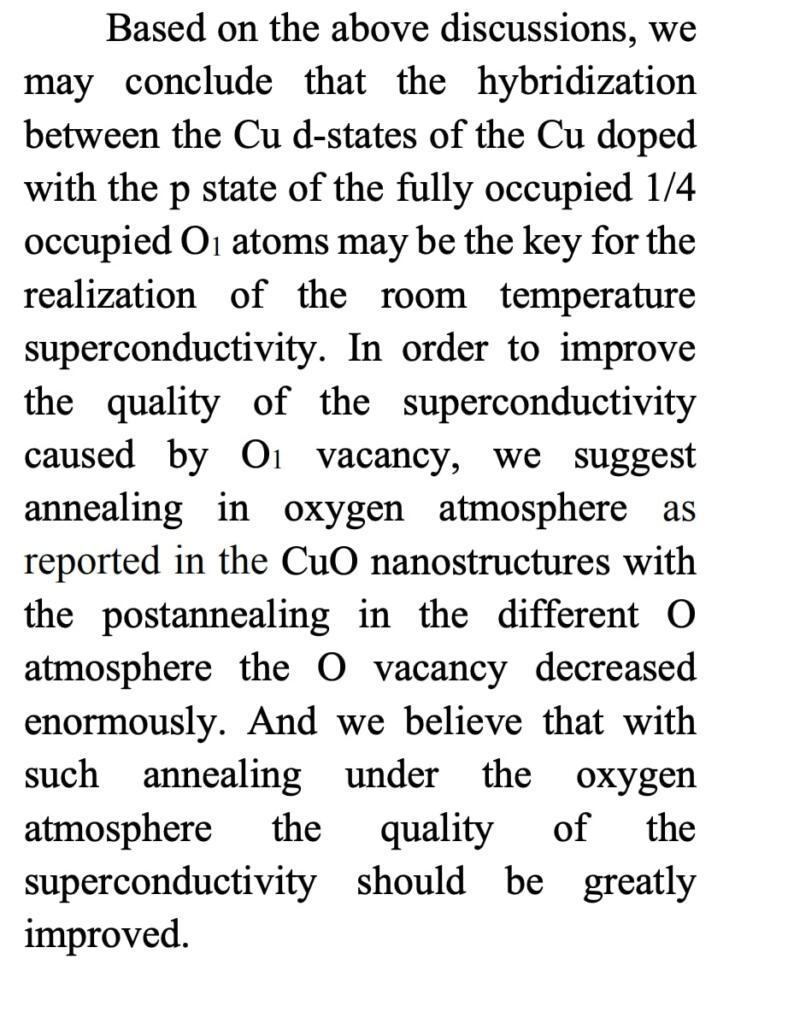Lanzhou University researchers analysis on improving the superconducting of LK99 with more oxygen. They conclude that the hybridization between the Cu d-states of the Cu doped with the p state of the fully occupied 1/4 occupied O1 atoms may be the key for the realization of the room temperature superconductivity. In order to improve the quality of the superconductivity caused by O1 vacancy. They suggest annealing in oxygen atmosphere as reported in the CuO nanostructures with the postannealing in the different O atmosphere the O vacancy decreased enormously. They believe that with such annealing under the oxygen atmosphere the quality of the superconductivity should be greatly improved.

Full occupied O1 atoms are very important, which results in a metal.
They find two types of the O atoms. The O1 atoms give the vital contributions to the flat band. The fully occupied O1 atoms reported in the literature determines the flat band. Since the O1 atoms are only 1/4 occupied, the O1 vacancies determines whether the flat bands exist or not.
In order to check their assumption right or not, they removed three out of four O1 atoms in calculations forming the Pb10(PO4)6O structure as reported by the experiments. It can be observed that the flat bands disappear. Because the bond length between the Pb1 atoms with that of the O1 atoms change from the 2.58 angstroms to 2.27 angstroms, such strong local distortion will result in the disappear of the flat band.
The O1 (oxygen 1) vacancies determines the electronic structure of the undoped lead-apatite crystal.
Calculations were performed in the framework of Density Functional Theory (DFT) as implemented in the Vienna Ab initio Simulation Package (VASP) package with the
projector augmented wave (PAW) potentials. The basis set contained plane waves with a kinetic energy cutoff of 520eV and the total energy was converged to 10^-6 eV. The Brillouin zone integration is carried out with 4*4*4 k-pointing sampling for undoped structures and with a Gamma-pointing sampling for the Cu doped structures of a 2*2 supercell of the Pb10-xCux(PO4)6O4 with x=0, 0.5. All geometries were optimized without any symmetry constraint until all residual forces on each atom were less than 0.01 eV/Å. And the width of the Gaussian smearing for the density of states calculations are set to be 0.05 eV.
Kun Tao*, Rongrong Chen, Lei Yang, Jin Gao, Desheng Xue and Chenglong Jia
Key Lab for Magnetism and Magnetic Materials of Ministry of Education, Lanzhou University, 730000 Lanzhou, China
Abstract
Based on the first principle calculations, we investigate the geometry and the electronic structures of the room temperature superconductor lead apatite with and without the Cu doped. Our calculations found that without the Cu doping the lead apatite crystal is an insulator with a flat band above the Fermi lever. Furthermore, our results indicate that by introducing the O1 vacancies would results in the disappear of the flat bands in the undopped crystal. While the Cu is doped forming the LK-99, there exist the ultra-flat bands crossing the Fermi level induced by the doped Cu atoms, which is due to the hybridization between the d states of the Cu atoms and the p states of the fully occupied 1/4 occupied O1 atoms. Moreover, we point out that the hybridization maybe the key for the realization of the room temperature superconductivity for the LK-99, and a possible solutions method to improve the quality of the superconductivity is proposed. Our work provides a foundation for the future studies on the unique electronic and the superconductivity properties of the LK-99 crystal.

Brian Wang is a Futurist Thought Leader and a popular Science blogger with 1 million readers per month. His blog Nextbigfuture.com is ranked #1 Science News Blog. It covers many disruptive technology and trends including Space, Robotics, Artificial Intelligence, Medicine, Anti-aging Biotechnology, and Nanotechnology.
Known for identifying cutting edge technologies, he is currently a Co-Founder of a startup and fundraiser for high potential early-stage companies. He is the Head of Research for Allocations for deep technology investments and an Angel Investor at Space Angels.
A frequent speaker at corporations, he has been a TEDx speaker, a Singularity University speaker and guest at numerous interviews for radio and podcasts. He is open to public speaking and advising engagements.


Somehow there’s no edit feature on this platform but this post supplants the prior with modified closing sentence:
This opens up the candidate list in untold ways. I had peripheral exposure as research assistant student to copper annealing and Oxygen typically played deleterious role for the metal state (oxidation). So one generally annealed in an oil bath. But ambient recrystallization happens and Oxygen exposure happens, albeit briefly.
The other effect which was my principal (Dr Clifford J Ball – Cantab, Fellow Royal Institute of Metal Physics) researcher’s interest area was Selenium which he implied to me has significant substitution with Oxygen in metallic state Copper.
Close my last reply with the Edit: … substitution with Oxygen in copper metallic state.
This opens up the candidate list in untold ways. I had peripheral exposure as research assistant student to copper annealing and Oxygen typically played deleterious role for the metal state (oxidation). So one generally annealed in an oil bath. But ambient recrystallization happens and Oxygen exposure happens, albeit briefly.
The other effect which was my principal (Dr Clifford J Ball – Cantab, Fellow Royal Institute of Metal Physics) researcher’s interest area was Selenium which he implied to me has significant substitution with copper in metal state.
Whatever happens, we will be exploring this rabbit hole for a long time to come: nice work.